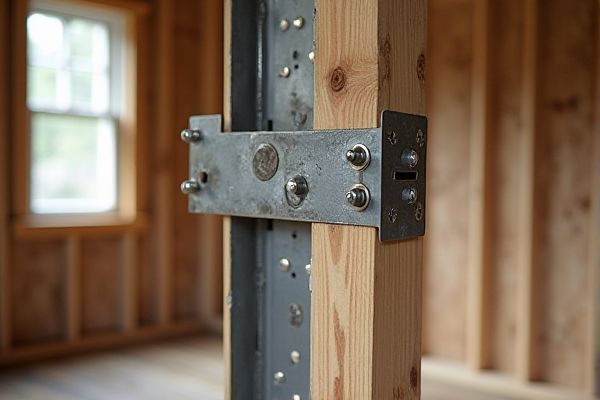
Steel plate stringers offer robust support with solid construction, ideal for heavy loads and industrial applications, while box stringers provide enhanced torsional rigidity and aesthetic clean lines, making them suitable for bridge decks and architectural designs. Explore the differences to determine which stringer best meets Your structural and design requirements in the full article.
Table of Comparison
| Feature | Steel Plate Stringer | Box Stringer |
|---|---|---|
| Structure | Single steel plate with welded stiffeners | Closed rectangular or square hollow section |
| Load Capacity | High bending resistance, moderate torsional stiffness | High bending and torsional stiffness |
| Weight | Generally lighter due to minimal material usage | Heavier due to enclosed design |
| Fabrication | Welding of plates and stiffeners, simpler process | Complex welding and fitting of multiple plates |
| Applications | Bridges, buildings requiring bending support | Structures subjected to torsion, bridges and heavy-duty frameworks |
| Cost | Lower fabrication and material cost | Higher cost due to complexity and material usage |
| Durability | Susceptible to corrosion on exposed surfaces | Better protection against corrosion, enclosed design |
Introduction to Steel Plate Stringer and Box Stringer
Steel plate stringers consist of solid steel plates welded together to form a robust structural beam, commonly used in bridges and heavy construction for their simplicity and strength. Box stringers are hollow, rectangular steel sections that provide higher torsional rigidity and reduced weight compared to solid plate stringers, enhancing structural efficiency. Understanding the differences between steel plate stringer and box stringer helps you select the right component based on load requirements and design constraints.
Structural Design Differences
Steel plate stringers consist of flat steel plates welded together to form an I-shaped or rectangular cross-section, providing high strength and ease of fabrication. Box stringers are hollow rectangular or square sections made from steel plates, offering enhanced torsional resistance and greater rigidity under load. Your choice depends on structural requirements, with steel plate stringers suited for straightforward bending loads, while box stringers excel in applications demanding superior torsional stiffness.
Material Composition and Strength
Steel plate stringers are primarily fabricated from high-strength carbon steel plates, offering excellent tensile strength and load-bearing capacity, making them ideal for heavy structural applications. Box stringers consist of welded steel plates forming a hollow rectangular cross-section, enhancing torsional rigidity and resistance to bending stresses due to their enclosed geometry. The material composition of both types typically involves ASTM A36 or A572 grade steel, with box stringers often benefiting from improved strength-to-weight ratios due to their structural form.
Load-Bearing Capacity Comparison
Steel plate stringers offer higher load-bearing capacity due to their solid, continuous web which efficiently distributes weight and resists bending under heavy loads. Box stringers, constructed from welded steel plates forming a closed hollow section, provide excellent torsional rigidity and resist buckling, making them suitable for uneven load distributions. Your choice depends on the specific load requirements and structural demands, with steel plate stringers preferred for maximum vertical strength and box stringers for enhanced stability in complex load scenarios.
Installation and Fabrication Processes
Steel plate stringers require precision welding and cutting techniques during fabrication, enabling customized shapes for varied load requirements, while installation demands exact alignment to support structural integrity. Box stringers, composed of welded hollow sections, simplify fabrication through modular assembly of plates, and installation benefits from their inherent torsional rigidity, reducing on-site adjustments. Both methods necessitate skilled labor, but box stringers often accelerate construction timelines due to prefabrication advantages in controlled environments.
Durability and Maintenance Requirements
Steel plate stringers offer high durability due to their solid construction, making them resistant to impact and heavy loads, but require regular maintenance to prevent corrosion and ensure longevity. Box stringers, characterized by their hollow, enclosed design, provide excellent strength-to-weight ratio and improved protection against environmental factors, reducing the frequency and extent of maintenance needed. Both types benefit from protective coatings, but box stringers typically demand less upkeep in harsh conditions, enhancing structural reliability over time.
Cost Analysis: Steel Plate vs Box Stringer
Steel plate stringers generally offer a lower initial cost due to simpler fabrication and reduced labor requirements compared to box stringers, which involve more complex welding and assembly processes. However, box stringers provide superior structural strength and durability, potentially lowering maintenance expenses over time and offering better long-term value. Your choice between these steel plate and box stringers should consider both upfront costs and lifecycle expenses to optimize budget efficiency.
Common Applications in Construction
Steel plate stringers are commonly used in bridge construction, industrial platforms, and heavy-duty staircases due to their strength and ease of fabrication. Box stringers find frequent application in pedestrian bridges, large-span structures, and architectural staircases where torsional rigidity and aesthetic appeal are critical. Both types are essential in infrastructure projects requiring durable load-bearing solutions tailored to specific structural demands.
Advantages and Disadvantages of Each Stringer Type
Steel plate stringers offer superior load distribution and are easier to fabricate, making them ideal for bridges and heavy-duty structures where strength and durability are paramount. Box stringers provide enhanced torsional stiffness and reduce material usage through their hollow, enclosed design, but they can be more complex and costly to manufacture and maintain. Your choice depends on factors like structural requirements, budget, and maintenance capabilities, balancing the advantages of strength and fabrication ease against torsional performance and lifecycle costs.
Choosing the Right Stringer for Your Project
Steel plate stringers provide robust strength and are ideal for heavy-load applications with straightforward fabrication, while box stringers offer enhanced torsional resistance and versatility for complex designs. Your project requirements, including load capacity, structural stability, and installation constraints, determine the optimal choice between these stringer types. Selecting the right stringer ensures durability, safety, and cost-efficiency tailored to your construction needs.
 homyna.com
homyna.com